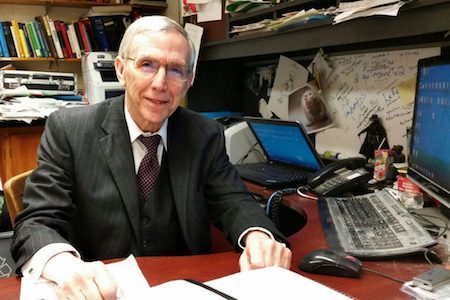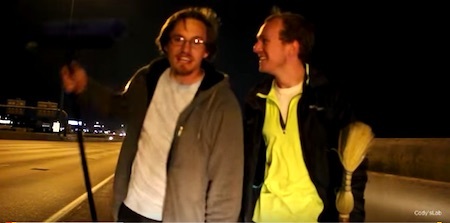Marc Abrahams's Blog, page 235
December 20, 2016
Lives of the great scientists: Professor Carrier meets the semicolon
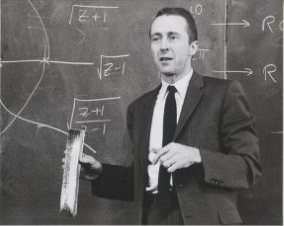 From the SIAM obituary of applied mathematician George Carrier:
From the SIAM obituary of applied mathematician George Carrier:
Not one to polish text, or to pursue a subject beyond the essence of what he wanted to know, he was nevertheless pleased when the late Sydney Goldstein (who, he said, introduced him to the use of the semicolon) praised his writing as concise and precise.

December 19, 2016
Human Zombie Brain Activity, Measured and Documented
In real life, so to speak, does the brain keep on keeping on for a while after death? A newly published study, written by notably adventurous academics, says that yes, the brain can and does, kinda sorta:
“When Is the Brain Dead? Living-Like Electrophysiological Responses and Photon Emissions from Applications of Neurotransmitters in Fixed Post-Mortem Human Brains,” Nicolas Rouleau, Nirosha J. Murugan, Lucas W.E. Tessaro, Justin N. Costa, Michael A. Persinger, PLoS ONE, vol. 11, no. 12, December 2016, e0167231. (Thanks to Dany Adams for bringing this to our attention.) The authors, at Laurentian University, Canada, explain:
“The structure of the post-mortem human brain can be preserved by immersing the organ within a fixative solution. Once the brain is perfused, cellular and histological features are maintained over extended periods of time. However, functions of the human brain are not assumed to be preserved beyond death and subsequent chemical fixation. Here we present a series of experiments which, together, refute this assumption. Instead, we suggest that chemical preservation of brain structure results in some retained functional capacity. Patterns similar to the living condition were elicited by chemical and electrical probes within coronal and sagittal sections of human temporal lobe structures that had been maintained in ethanol-formalin-acetic acid…. these results suggest that portions of the post-mortem human brain may retain latent capacities to respond with potential life-like and virtual properties.”
Co-author Persinger has made his mark many ways in and about academia.
This photograph of Professor Persinger appears in the January 10, 2016 issue of The Star. The photo was taken by Nicolas Rouleau, another co-author of the zombie brain paper.
The article that accompanies that photo in The Star begins:
The ethical failure of the swearing Laurentian professor
The case of a Laurentian University professor pulled from his class after asking students to agree to his use of vulgar language holds important lessons for university teachers…
Professor Persinger is famed, also, for having co-invented the God Helmet. and for his other work in parapsychology. We profiled Professor Persinger here a couple of years ago, in three parts: 1, 2, and 3.
Professor Persinger and Professor Rouleau recently reported seeing signs of learning in a ball of dough.
BONUS (related to the brain activity study): The 2012 Ig Nobel Prize for neuroscience was awarded to Craig Bennett, Abigail Baird, Michael Miller, and George Wolford, for demonstrating that brain researchers, by using complicated instruments and simple statistics, can see meaningful brain activity anywhere — even in a dead salmon.

Earworms, Daydreams and Cognitive Capitalism (new study)
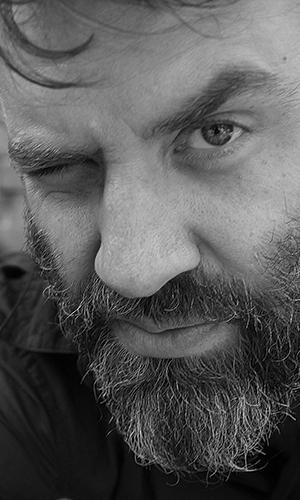 Although the cognitive neurosciences are currently conducting research to determine the brain networks that might be implicated in the production of ‘earworms’ – what about their role in contemporary capitalism’s encroachment on human cognitive capacities? For a discussion on this subject see the work of Eldritch Priest who is Visiting Assistant Professor of Music at New York University and Assistant Professor at Simon Fraser University School for the Contemporary Arts. The professor approaches the earworm from a deliberately speculative perspective in his essay ‘Earworms, Daydreams and Cognitive Capitalism’ (Theory, Culture & Society, October 4, 2016)
Although the cognitive neurosciences are currently conducting research to determine the brain networks that might be implicated in the production of ‘earworms’ – what about their role in contemporary capitalism’s encroachment on human cognitive capacities? For a discussion on this subject see the work of Eldritch Priest who is Visiting Assistant Professor of Music at New York University and Assistant Professor at Simon Fraser University School for the Contemporary Arts. The professor approaches the earworm from a deliberately speculative perspective in his essay ‘Earworms, Daydreams and Cognitive Capitalism’ (Theory, Culture & Society, October 4, 2016)
“[…] I approach the earworm from a deliberately speculative perspective in order to conceptualize its appearance not as a mere neurological anomaly but as a technical matter expressive of the way historically useless thinking, the kind of thinking we associate with reverie and brooding, is being rhetorically and imaginatively recuperated as a passive technology of the self.”
And, continuing :
“Earworms are, then, expressive of a sheer fluctuation, a lived abstraction, or a pure sign of variation that epitomizes entertainment’s principle of indigestion. But at the same time earworms mark the limits and fate of indigestion. Their play of appearance and disappearance short-circuits the bureaucracy of organism in a way that brings out the latter’s power of variation and capacity to perform, communicate and relate to a place ‘where things reach their end without passing through their means’ (Baudrillard, 2008: 192).
This is to say that earworms are the destiny of musical technics taken up in an apparatus of distraction, the destiny of indigestion where music ‘attains [its] effects without passing through causes’ (Baudrillard, 2008: 192). A something doing becoming thought that is becoming something doing.”
Bonus: The professor, who is also a composer, provides a selection of his music (audio and scores) here at his website Stangemonk.com
Here is a performance of glossolalia (stress positions) (2008), 25’00, flute, bass clarinet, violin, contrabass, and vibraphone. Commissioned by Western Front, Vancouver; premièred by Motion Ensemble.
Also don’t miss: ‘Boring Formless Nonsense : Experimental Music and the Aesthetics of Failure’ – Eldritch Priest, Bloomsbury Academic, Paperback, Dimensions: 5 1/2″ x 8 1/2″, List price: $34.95

December 18, 2016
Two buddies in search of platinum on the highway in the middle of the night
This video is a buddy film, or sorts: it shows CodyDon Reeder and his buddy sweeping dust from the side of a highway in the middle of the night, then working to chemically retrieve (from that dust) platinum bits — presumably shed from the catalytic converters of passing automobiles:
(Thanks to Scott Langill for bringing this to our attention.)

December 17, 2016
“A chicken is a Dirac limit of a tyrannosaur”
The cute-as-a-jingle phrase “a chicken is a Dirac limit of a tyrannosaur” emerges in the final section of a study called “Diagonalizing the genome II: toward possible applications,” by Satyan L. Devadoss and Jack Morava.

A chicken.
Here’s the full passage in which that phrase crops up:
“Branching in descent diagrams can be modeled by specialization in the sense of algebraic geometry, defined (for example) by fixing some parameter. In the language of stratified spaces this corresponds to moving from the interior of some region to its boundary: something like a phase change (like water to ice). In such a cartoon description, a chicken is a Dirac limit of a tyrannosaur, in which many of its genetic parameters tend to zero. At this level of vagueness, there is reason to work with codimension than with probability: evolutionary events are highly unlikely, and in reasonable models will have effective probability zero; but in geometry any subspace of positive codimension has measure, and hence probability, zero. The modern theory of phase change in condensed matter physics has developed powerful tools for the study of such transitions (viewed as moving towards a stratum boundary, eg of some phenotype), but in current work there is usually only one such event in focus at a given moment. Evolution forces us to consider long concatenations of such events, and trees are a natural tool for their book-keeping.”
(Thanks to Mason Porter for bringing this to our attention.)
BONUS (distantly related, as most things are): “Pretty Good Gravity, by Jack Morava.

December 15, 2016
A Time/Cost Assessment of Toilet-Paper Folding, Worldwide
Three Swedish researchers spent time estimating the aggregate time spent folding the corners of toilet paper. They published this study (which tells only their estimate of how much time those other people spent folding, but does not disclose how much time the authors spent calculating and writing):
 “It is worth 10 million working hours a year to have your toilet paper folded?” Rickard Ljung [pictured here], Hedvig Ljung and Harald Ljung, Journal of Occupational Medicine and Toxicology, vol. 11, no. 38, 2016. The authors, at the Karolinska Institutet, Stockholm, Sweden, report:
“It is worth 10 million working hours a year to have your toilet paper folded?” Rickard Ljung [pictured here], Hedvig Ljung and Harald Ljung, Journal of Occupational Medicine and Toxicology, vol. 11, no. 38, 2016. The authors, at the Karolinska Institutet, Stockholm, Sweden, report:
“From our experience the toilet paper is folded in the bathrooms in rooms in branded hotels. We aimed to study the total time yearly spent in the world on folding hotel toilet paper…. Assuming an extra 10 s spent on folding toilet paper, approximately 10 million hours are globally spent on folding toilet paper every year. This corresponds to more than 5000 man-years of work. In a hotel with yearly full coverage of 200 beds skipping folding the toilet paper corresponds to around 200 h of time that could be spent elsewhere.”
Ross Pomeroy provides additional details, writing in RealClear Science.
BONUS: In this four-and-a-half-minute-long video, Elen Correa — who is not part of the research team, and may not be aware of their calculations — shows how she folds toilet paper:

The world’s first “Pastarimeter” — lefty pasta and righty pasta
“Our experience of explaining polarimetry to the general public is that they frequently ask how molecules rotate light, which is difficult to explain using non-technical language. Therefore we were keen to find an analogous large scale system which mimicked the polarimeter and used everyday left- and right-handed objects.”
– explain Claire Saxon, Scott Brindley, Nic Jervis, Graeme R. Jones, E. David Morgan, and Christopher A. Ramsden of the School of Chemistry and Physics, Lennard-Jones Laboratories, Keele University, UK. Between them, they have developed the world’s first “Pastarimeter” – inspired by an idea from the late Nobel Laureate Sir Robert Robinson, OM PRS FRSE, whom, whilst working at the University of Sydney in 1914, had shown that short lengths of left- or right-handed screw threads packed into a tube would rotate a stream of water flowing down the tube – perhaps in some ways analogous to the way that chiral molecules rotate light.
“We are now pleased to report that we have succeeded in repeating this experiment and confirming Robinson’s observations. The major stumbling block in the past has been the availability of a left- and right-handed threaded material with a suitably deep thread. We have now found a remarkably cheap and disposable source in our local supermarket in the form of pasta fusilli. Surprising as it may seem, these are available from various retailers in both left- and right-handed forms.”
• See: The World’s First “Pastarimeter”: An Analogous Demonstration of Polarimetry Using Pasta Fusilli J. Chem. Educ., 2002, 79 (10), p 1214.
• Note: Their paper notes an interesting example of how identical molecules – identical that is except for the direction in which they twist – can have wildly differing properties. They cite the case of carvone – a molecule which tastes of spearmint when it twists in one direction and caraway in the other.
• Assignment [optional]: Which other types of pasta exhibit chirality? [references here]
• Also see: Pasta’s place in the history of superconductivity
• Also don’t miss: ‘A taste for anelloni’ from the University of Warwick, UK (using Möbius pasta to illustrate the mysteries of ring-shaped polymers).
• And finally [chirality-in-the-news related] : Help find Jeremy the ‘lefty’ snail a mate , BBC News, Oct. 2016
Still want more pasta analogies? . . .
See Nuclear Pasta (a type of degenerate matter found within the crusts of neutron stars) at Wikipedia :
“When the gnocchi phase is compressed, as would be expected in deeper layers of the crust, the electric repulsion of the protons in the gnocchi is not fully sufficient to support the existence of the individual spheres, and they are crushed into long rods, which, depending on their length, can contain many thousands of nucleons. Immersed in a neutron liquid, these rods are known as the spaghetti phase. Further compression causes the spaghetti phase rods to fuse, and form sheets of nuclear matter. This is called the lasagna phase.”

December 14, 2016
An Absence of Squamous Mucosa in Your Hot Dog
Hot dogs, having caught the attention of two doctors, got a post-postmortem of sorts, in this new study:
“What’s in Your Hot Dog? A Histological Comparative Analysis,” Tyler Rouse, Jordan Radigan, Medical Journal of Australia, vol. 205, no. 11, 2016, pp. 519-520. The authors report:
The contents of hot dogs (also known as street meat, tube steaks, frankfurters, wieners, etc) have been a source of speculation in popular culture…. The oral mucosa from the vermillion border and anuses of large mammalian domesticated animals has been postulated….
Specimens were procured both from vendors in a public location and from a commercial supermarket…. Sections from all specimens showed similar histological composition. [The] majority of the cross-sections of hot dogs consisted of fat globules. There was a wide but consistent range of tissues present, including but not limited to: bone, cartilage, blood vessels, skeletal muscle and… fragments of vegetable matter…. However, no squamous mucosa was identified.
Here’s further detail — an image from the study:
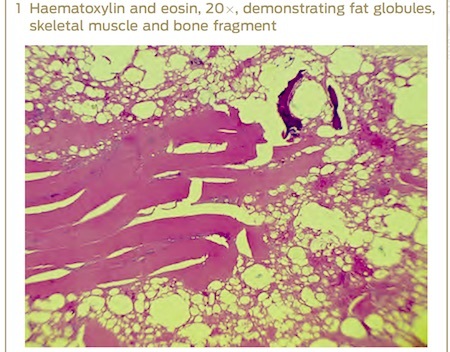
BONUS: The incoming Secretary of Energy for the USA, the government official in charge of overseeing the nation’s nuclear weapons and nuclear weapons research, is reported to have a background in meat:

Do Frogs in Helium Get Squeaky Voices? (Podcast #94)
Do frogs get all high-voiced when they breathe in some helium, the way people do? A research study explores that very question, and we explore that study, in this week’s Improbable Research podcast.
SUBSCRIBE on Play.it, iTunes, or Spotify to get a new episode every week, free.
This week, Marc Abrahams discusses a published helium-filled study, with dramatic readings from Dany Adams, a biology professor at Tufts University who uses electricity to make animals grow new limbs, and uses light to make cancer retreat in some animals.
For more info about what we discuss this week, go explore:
“Frogs in helium: the anuran vocal sac is not a cavity resonator,” A.S. Rand and R. Dudley, Physiological Zoology, vol. 66, 1993, pp. 793-806.
Cavity resonator.
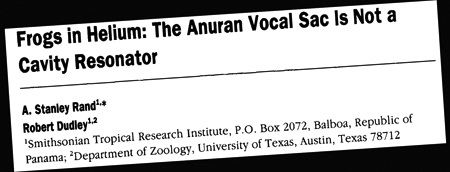
The mysterious John Schedler or the shadowy Bruce Petschek perhaps did the sound engineering this week.
The Improbable Research podcast is all about research that makes people LAUGH, then THINK — real research, about anything and everything, from everywhere —research that may be good or bad, important or trivial, valuable or worthless. CBS distributes it, on the CBS Play.it web site, and on iTunes and Spotify).
NEXT POST: xxxxx

December 13, 2016
Blais sings, in parallel, of quantum gravity
Timothy Blais acted out his master’s thesis (which is called “A new quantization condition for parity-violating three-dimensional gravity“) in a manner unusual for a physicist. He sang it, in n-part harmony, to the tune of Queen’s “Bohemian Rhapsody”:
(Thanks to Andrea Rapisarda for bringing this to our attention.)
BONUS: An older, printer-performed version of the song, which may or may not give insights into quantum gravity:

Marc Abrahams's Blog
- Marc Abrahams's profile
- 14 followers


